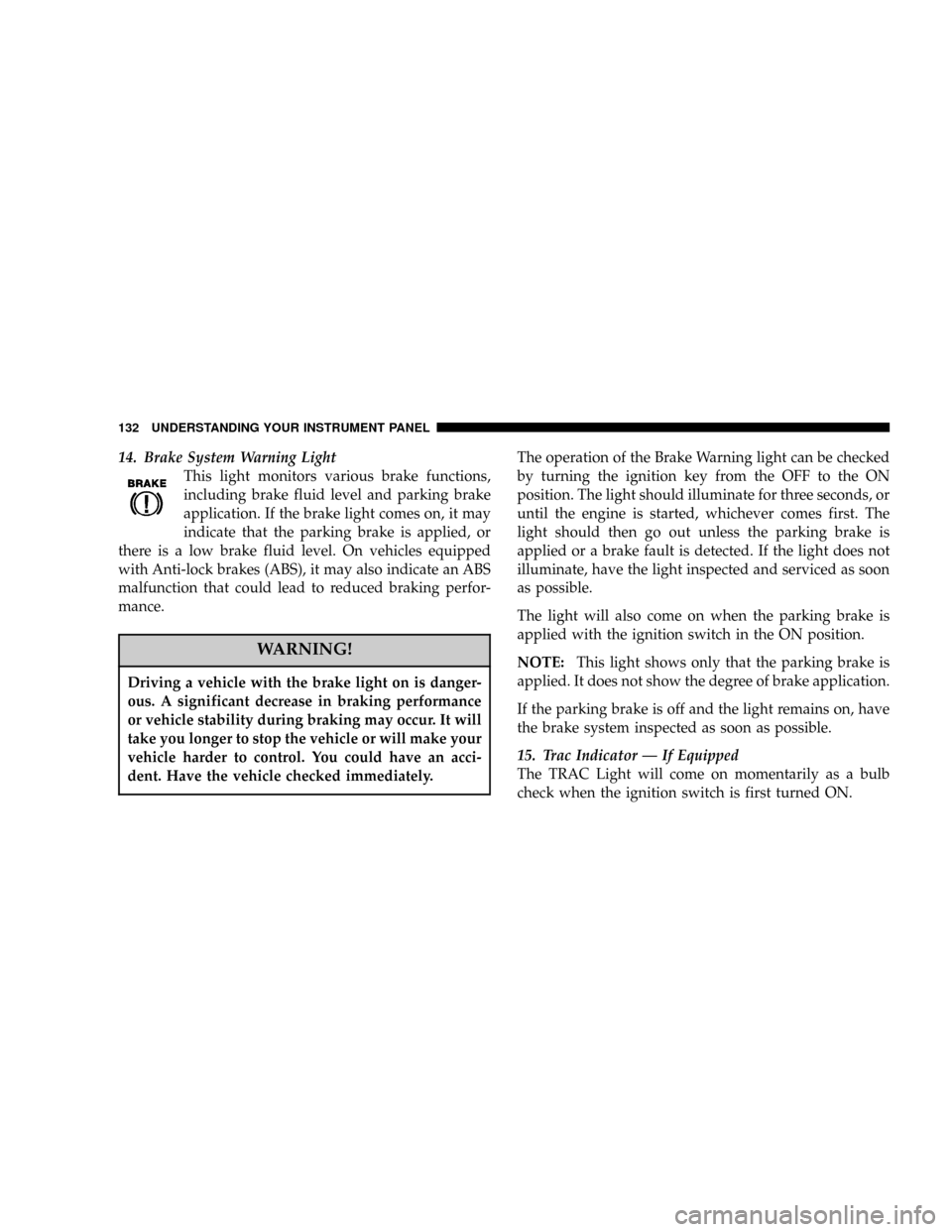Engine CHRYSLER PT CRUISER 2004 1.G User Guide
[x] Cancel search | Manufacturer: CHRYSLER, Model Year: 2004, Model line: PT CRUISER, Model: CHRYSLER PT CRUISER 2004 1.GPages: 341, PDF Size: 5.06 MB
Page 92 of 341

TO OPEN AND CLOSE THE HOOD
To open the hood, two latches must be released. First pull
the hood release lever located under the left side of the
instrument panel.
Then move the safety catch located under the front edge
of the hood, near the center and slightly to the right, and
raise the hood.Use the hood prop rod clipped to the driver's side of the
engine compartment to secure the hood in the open
position. Place the hood prop at the location stamped into
the inner hood surface.
To prevent possible damage, do not slam the hood to
close it. Lower the hood until it is open approximately 20
cm (8 inches) and then drop it. This should secure both
latches. Never drive your vehicle unless the hood is fully
closed, with both latches engaged.
WARNING!
If the hood is not fully latched it could fly up when
the vehicle is moving and block your forward vision.
You could have a collision. Be sure all hood latches
are fully latched before driving.
92 UNDERSTANDING THE FEATURES OF YOUR VEHICLE
Page 99 of 341

CAUTION!
In cold weather, always turn off the wiper switch
and allow the wipers to return to the park position
before turning off the engine. If the wiper switch is
left on and the wipers freeze to the windshield,
damage to the wiper motor may occur when the
vehicle is restarted.
Windshield Wiper Operation
Move the lever upward to the second detent for Low
speed wiper operation, or to the third detent for High
speed operation
Intermittent Wiper System
Use the intermittent wiper when weather conditions
make a single wiping cycle, with a variable pause be-
tween cycles, desirable. Move the lever to the DEL
position, then select the delay interval by turning the end
of the lever. Rotate the knob upward (clockwise) to
decrease the delay time and downward (counterclock-
wise) to increase the delay time. The delay can be
regulated from a maximum of approximately 18 seconds
between cycles, to a cycle every second.
UNDERSTANDING THE FEATURES OF YOUR VEHICLE 99
3
Page 103 of 341

To Resume Speed:
To resume a previously set speed, push the ªACC/RESº
lever up and release. Resume can be used at any speed
above 20 mph (32 km/h).
To Vary The Speed Setting:
When the speed control is ON, speed can be increased by
pushing up and holding ªACC/RESº. Release the lever
when the desired speed is reached, and the new speed
will be set.
Tapping ªACC/RESº once will result in a 2 mph (3
km/h) speed increase. Each time the lever is tapped,
speed increases so that tapping the lever three times will
increase speed by 6 mph (10 km/h), etc.
To decrease speed while speed control is ON, push down
and hold ªCOAST/SETº. Release the lever when the
desired speed is reached, and the new speed will be set.Tapping the ªCOAST/SETº button once will result in a 1
mph (2 km/h) speed decrease. Each time the button is
tapped, speed decreases.
Manual Transaxle:
Depressing the clutch pedal will disengage the speed
control. A slight increase in engine RPM before the speed
control disengages is normal.
Vehicles equipped with manual transaxles may need to be
shifted into a lower gear to climb hills without speed loss.
WARNING!
Speed Control can be dangerous where the system
can't maintain a constant speed. Your vehicle could
go too fast for the conditions, and you could lose
control. An accident could be the result. Don't use
Speed Control in heavy traffic or on roads that are
winding, icy, snow-covered, or slippery.
UNDERSTANDING THE FEATURES OF YOUR VEHICLE 103
3
Page 107 of 341

Manual Compass Calibration
If the compass appears erratic, inaccurate, abnormal or
the vehicle is new, you may calibrate the compass. Prior
to calibrating the compass make sure the proper zone is
selected. Refer to ªMagnetic Zone Selectionº.Find an
open area away from large metal objects. With the vehicle
running, press and hold the STEP button for (about 10 to
15 seconds). The display will illuminate the CAL indica-
tor. Drive slowly (about 5 mph) in 3 complete 360 circles.
The CAL indicator will turn off and the compass will be
calibrated.
NOTE:
²The compass needs to go through a manual calibration
to insure proper operation when taking vehicle deliv-
ery.
²The STEP button must be pressed for 10 to 15 seconds
to place the compass into CAL mode. Regardless of
whether the CAL indicator is already illuminated.
Outside Temperature
Because engine temperature can increase the displayed
temperature, temperature readings are not updated
when the vehicle is not moving.
If the display shows249ÉF (245ÉC) or 140ÉF (60ÉC), see
your authorized dealer for repair.
UNDERSTANDING THE FEATURES OF YOUR VEHICLE 107
3
Page 112 of 341

Electrical Outlet Use With Engine Off
CAUTION!
²Many accessories that can be plugged in draw
power from the vehicle's battery, even when not
in use (i.e. cellular phones, etc.). Eventually, if
plugged in long enough, the vehicle's battery will
discharge sufficiently to degrade battery life
and/or prevent engine starting.
²Accessories that draw higher power (i.e. coolers,
vacuum cleaners, lights, etc.), will degrade the
battery even more quickly. Only use these inter-
mittently and with greater caution.
²After the use of high power draw accessories, or
long periods of the vehicle not being started (with
accessories still plugged in), the vehicle must be
driven a sufficient length of time to allow the
generator to recharge the vehicle's battery.
CONSOLE FEATURES
The console has two front cup holders, a coin holder, 12
volt power outlet and a front storage tray. There are
additional cup holders; one is molded in the center of the
console to hold large cups and the other is at the rear of
the console to serve passengers in the rear seat. The floor
console power outlet will also operate a conventional
cigar lighter unit (if equipped with an optional Smoker's
Package).
112 UNDERSTANDING THE FEATURES OF YOUR VEHICLE
Page 113 of 341

CAUTION!
²Many accessories that can be plugged into the 12
volt power outlet, draw power from the vehicle's
battery, even when not in use; i.e. cellular phones,
etc. Eventually, if plugged in long enough, the
vehicle's battery will discharge sufficiently to
degrade battery life and/or prevent engine start-
ing.
²Accessories that draw higher power such as cool-
ers, vacuum cleaners, lights, etc., will discharge
the battery even more quickly. Only use these
intermittently and with greater caution.
²After the use of high power draw accessories, or
long periods of the vehicle not being started,
(with accessories still plugged in), the vehicle
must be driven a sufficient length of time to allow
the generator to recharge the vehicle's battery.
UNDERSTANDING THE FEATURES OF YOUR VEHICLE 113
3
Page 129 of 341

INSTRUMENT CLUSTER DESCRIPTIONS
1. Fuel Gauge
When the ignition switch is in the ON position, the
pointer will show the level of fuel remaining in the
fuel tank.
2. Charging System Light
This light shows the status of the electrical charg-
ing system. The light should come on briefly when
the ignition is first turned ON and remain on briefly as a
bulb check. If the light stays on or comes on while
driving, it means that there is a problem with the
charging system. Obtain SERVICE IMMEDIATELY.
3. Liftgate Ajar
This light comes on if the liftgate is not com-
pletely closed.4. Oil Pressure Light
Shows low engine oil pressure. The light will come
on and remain on when the ignition switch is
turned from the OFF to the ON position, and the light
will turn off after the engine is started. If the bulb does
not come on during starting, have the system checked by
an authorized dealer.
If the light comes on and remains on while driving, stop
the vehicle and shut off the engine. DO NOT OPERATE
THE VEHICLE UNTIL THE CAUSE IS CORRECTED.
The light does not show the quantity of oil in the engine.
This can be determined using the procedure shown in
Section 7.
5. Theft Alarm Light Ð If Equipped
This light will flash rapidly for several seconds when the
alarm system is arming. The light will begin to flash
slowly indicating that the system is armed.
UNDERSTANDING YOUR INSTRUMENT PANEL 129
4
Page 130 of 341

6. Engine Temperature Warning Light
This light warns of an overheated engine condi-
tion. If the engine is critically hot, a warning chime
will sound 10 times. After the chime turns off, the
engine will still be critically hot until the light goes out.
7. Turn Signal Indicators
The arrows will flash in unison with the exterior
turn signal, when using the turn signal lever.
NOTE:Turn signal bulbs are located in the Instrument
Panel.
8. Temperature Gauge
The temperature gauge shows engine coolant tem-
perature. Any reading below the red area of the
gauge shows that the engine cooling system is
operating properly. The gauge pointer may show a
higher than normal temperature when driving in hot
weather, up mountain grades, in heavy stop and go
traffic, or when towing a trailer.If the pointer rises to theH(red) mark, the instrument
cluster will sound a chime. Pull over and stop the vehicle.
Idle the vehicle with the air conditioner turned off until
the pointer drops back into the normal range. If the
pointer remains on theH(red) mark, turn the engine off
immediately and call for service.
There are steps that you can take to slow down an
impending overheat condition. If your air conditioning is
on, turn it off. The air conditioning system adds heat to
the engine cooling system and turning off the A/C
removes this heat. You can also turn the Temperature
control to maximum heat, the Mode control to Floor and
the Fan control to High. This allows the heater core to act
as a supplement to the radiator and aids in removing heat
from the engine cooling system.
9. Speedometer
Indicates vehicle speed.
130 UNDERSTANDING YOUR INSTRUMENT PANEL
Page 131 of 341

10. High Beam Indicator
This light shows that the headlights are on high
beam. Pull the turn signal lever toward the steer-
ing wheel to switch the headlights from high or low
beam.
11. Tachometer
The white area of the scale shows the permissible engine
revolutions-per-minute (rpm x 1000) for each gear range.
Before reaching the red area, ease up on the accelerator to
prevent engine damage.
12. Anti-Lock Warning Light (ABS) Ð If Equipped
This light monitors the Anti-Lock Brake System
(ABS) described elsewhere in this manual. This
light will come on when the ignition key is
turned to the ON position and may stay on for
as long as four seconds.
If the ABS light remains on or comes on during driving,
it indicates that the Anti-Lock portion of the brake systemis not functioning and that service is required, however,
the conventional brake system will continue to operate
normally provided that the BRAKE warning light is not
on.
If the ABS light is on, the brake system should be serviced
as soon as possible to restore the benefit of Anti-Lock
Brakes.
The warning light should be checked frequently to assure
that it is operating properly. Turn the ignition key to the
on position, but do not start the vehicle. The light should
come on. If the light does not come on, have the system
checked by an authorized dealer.
13. Seat Belt Reminder Light
When the ignition switch is first turned ON, this
light will come on for about six seconds. A chime
will sound if you have not pulled the shoulder belt
out of the retractor. This is a reminder to ªbuckle upº. If
you do not buckle up, the light will remain on.
UNDERSTANDING YOUR INSTRUMENT PANEL 131
4
Page 132 of 341

14. Brake System Warning Light
This light monitors various brake functions,
including brake fluid level and parking brake
application. If the brake light comes on, it may
indicate that the parking brake is applied, or
there is a low brake fluid level. On vehicles equipped
with Anti-lock brakes (ABS), it may also indicate an ABS
malfunction that could lead to reduced braking perfor-
mance.
WARNING!
Driving a vehicle with the brake light on is danger-
ous. A significant decrease in braking performance
or vehicle stability during braking may occur. It will
take you longer to stop the vehicle or will make your
vehicle harder to control. You could have an acci-
dent. Have the vehicle checked immediately.
The operation of the Brake Warning light can be checked
by turning the ignition key from the OFF to the ON
position. The light should illuminate for three seconds, or
until the engine is started, whichever comes first. The
light should then go out unless the parking brake is
applied or a brake fault is detected. If the light does not
illuminate, have the light inspected and serviced as soon
as possible.
The light will also come on when the parking brake is
applied with the ignition switch in the ON position.
NOTE:This light shows only that the parking brake is
applied. It does not show the degree of brake application.
If the parking brake is off and the light remains on, have
the brake system inspected as soon as possible.
15. Trac Indicator Ð If Equipped
The TRAC Light will come on momentarily as a bulb
check when the ignition switch is first turned ON.
132 UNDERSTANDING YOUR INSTRUMENT PANEL